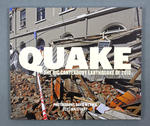
Cracks in the road seal on Avonside Drive from the 4 September 2010 earthquake.

Cracks in the road seal on Avonside Drive from the 4 September 2010 earthquake.

Maps comparing road repairs needed after the 4 September 2010 and 22 February 2011 earthquakes.

A footpath on Galbraith Avenue in Avonside showing cracking from the 4 September 2010 earthquake.

One multi-coloured soft-cover book entitled 'Quake: the Big Canterbury Earthquake of 2010' with colour photographs by David Wethey and text by Ian Stuart. ‘Quake: The Big Canterbury Earthquake of 2010’ contains aerial photographs of the damage to many major heritage sites in Canterbury between Kaiapoi and Darfield after the 4 September 2010 ear...

One landscape colour digital photograph taken on 19 November 2011 showing posters for the outdoor theatre production 'The Pirates of Corsair Bay' and the 2011 Lyttelton Summer Festival events scheduled for February and March 2011. The posters remained in the window of the red stickered building until it was demolished in early September 2012. A...

Charts showing the reduction in visitor numbers to Christchurch following the 4 September 2010 earthquake.

A footpath on Galbraith Avenue in Avonside showing cracking from the 4 September 2010 earthquake.

A section of road on Avonside Drive showing damage from the 4 September 2010 earthquake.

A damaged brick building has wooden bracing holding the walls together. The photographer comments, "This building came through the September Christchurch quake with a few band aid plasters, but the February quake means that she is now DNR (Do Not Resuscitate)".

A brick wall has fallen from this house, exposing the rooms within and leaving a pile of rubble in front. The ceiling has slumped and is held up with jacks. The photographer comments, "This was probably the result of the shallower February Christchurch earthquake rather than the bigger September one".

A graphic describing changes Cantabrians have made to their lives following the 4 September 2010 earthquake.

A graph showing the effect the 4 September 2010 earthquake had on investor confidence in Christchurch.

One landscape colour digital photograph taken on 14 July 2011 showing damage to the Lyttelton Historical Museum on the corner of Gladstone Quay and Donald Street. The photograph shows the safety fencing and containers installed after the 22 February 2011 earthquakes. Architect Closed after the September 2010 earthquakes, the Lyttelton Museum bu...

One landscape colour digital photograph taken on 16 June 2011 showing the site of the Timeball Station after its collapse. Part of the ground floor remains visible. Photograph taken from Oxford Street Overbridge. Architect The 13 June 2011 earthquakes caused the collapse of the already damaged Lyttelton Timeball Station. After the 22 February ...

A large crack in Robson Avenue in Avonside that has resulted from the 4 September 2010 earthquake.

The Medway Street footbridge over the Avon River in Avonside, warped in the 4 September 2010 earthquake.

The Medway Street footbridge over the Avon River in Avonside, warped in the 4 September 2010 earthquake.

Photograph captioned by BeckerFraserPhotos, "People outside the Canterbury Museum. The Museum re-opened to the public on 4 September, 2011".

One portrait colour digital photograph taken on 19 November 2011 showing the flyers in the window of the Lyttelton Information Centre on Oxford Street. The building was closed from 22 February 2011 until April 2013 due to the danger posed by the neighbouring building and then while repairs were scheduled and carried out. The flyers provided a sn...

One landscape colour digital photograph taken on 19 November 2011 showing the site of the old Lyttelton Library, Council Chambers and Magistrates' Court on the corner of Oxford Street and Sumner Road. At the time of the 22 February 2011 Earthquake the building was in private ownership and was the premises of Moda Fotografica and a private resid...

A table giving statistics on injuries in the 4 September 2010 and 22 February 2011 earthquakes.

A map showing the extent of liquefaction caused by the 4 September 2010 and 22 February 2011 earthquakes.

Photograph captioned by BeckerFraserPhotos, "Sign erected after 4 September earthquake - Rebuild, brick by brick. Salisbury Street".

A motion-blurred photograph of houses, with the Port Hills in the background. The photographer comments, "This I hope gives you a feel of what it feels like in an earthquake. When you spend your whole life thinking that you and your home are built on solid ground, it can be quite a shock when you find it is not. You can feel the house shaking like a dog with a toy, rising up violently underneath you or the most gentle form which is when the ground moves gently like a wave moving under a rowing boat. It is not just the movement, you often get a rumbling sound which can precede a violent shake or can result in no movement at all. This means that some vehicles can sound like the rumbling initially and in the early days would get your heart racing. Another form of stress is when big excavators as heavy as a tank move as you can feel the ground shake from streets away, but you do not always hear the engine. For most of us the problem when the shaking starts, is wondering if this is the start of an extremely violent earthquake or will it peter out".

The driveway of a house on Galbraith Avenue in Avonside showing cracks resulting from the 4 September 2010 earthquake.

An infographic giving information on events to be held to commemorate the anniversary of the 4 September 2010 earthquake.

A view down Galbraith Avenue in Avonside. The footpath has been badly damaged by the 4 September 2010 earthquake.

The garden path of a house on Robson Avenue in Avonside showing cracks from the 4 September 2010 earthquake.

A map showing the extent of liquefaction after the 4 September 2010 and 22 February 2011 earthquakes.